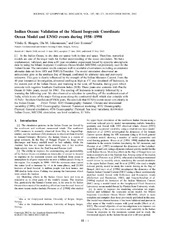Indian Ocean: Validation of the Miami Isopycnic Coordinate Ocean Model and ENSO events during 1958–1998
Journal article

Åpne
Permanent lenke
https://hdl.handle.net/1956/792Utgivelsesdato
2002-05-25Metadata
Vis full innførselSamlinger
Originalversjon
https://doi.org/10.1029/2000jc000330Sammendrag
In the Indian Ocean, in situ data are sparse both in time and space. Therefore, numerical models are one of the major tools for further understanding of the ocean circulation. We have implemented, validated, and done a 40 year simulation experiment forced by synoptic atmospheric data by using the Miami Isopycnic Coordinate Ocean Model (MICOM) not previously used for the Indian Ocean. The simulation results compare well to available observations including an extensive altimeter data set from ERS and TOPEX/Poseidon. The model simulation discovered an anticyclonic gyre in the southern Bay of Bengal, confirmed by altimeter data and previously unknown. This gyre is clearly influenced by the strength of the Indian Monsoon Current. From the 40 year interannual investigation, abnormal cooling as high as 4ºC was simulated off Indonesia, in the eastern part of the Indian Ocean, and warming in the west, off Somalia, during years which coincide with negative Southern Oscillation Index (SOI). These years also coincide with Pacific Ocean El Ninõ years, except for 1961. The cooling off Indonesia is normally followed by a warming the following year. We also observed a reduction in upwelling off the southwest coast of India, which is one of the major fishing areas along the continental shelf, which also coincide with El Ninõ–Southern Oscillation (ENSO) years. We conclude that El Ninõ events occur very clearly in the Indian Ocean.